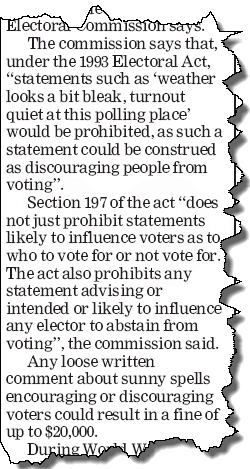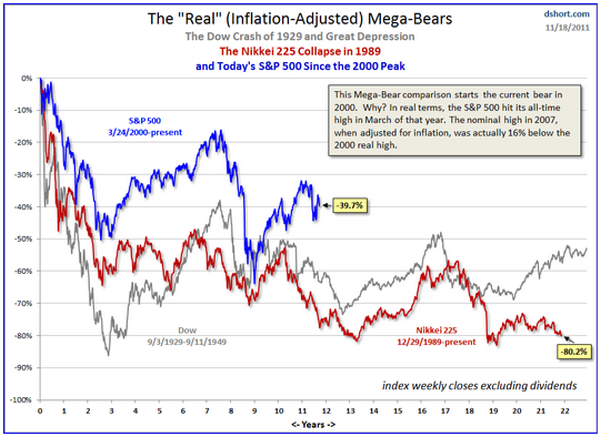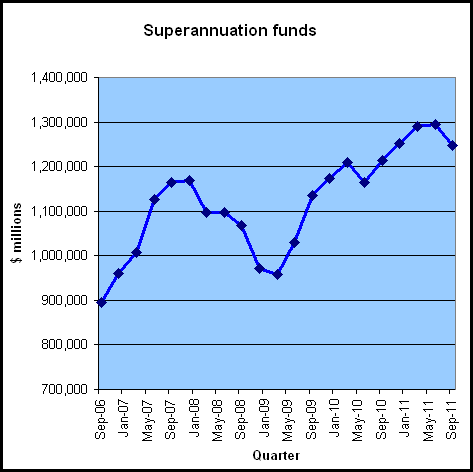$20,000 for saying it’s raining. From New Zealand’s The Press this morning:

The Press story recalls that former Labour Prime Minister David Lange made perhaps the most famous election forecast of the last 30 years. He suggested before the 1984 election that Labour would defeat Sir Robert Muldoon’s National government even if the country was under a foot of snow on polling day.
As it turned out, about a quarter of New Zealand was, with returning officers in Otago and Southland seriously considering deferring voting due to blizzard-like conditions.
If the Crikey NZ Election Indicator is any guide it will take something more miraculous that a foot of snow to see the National government lose this weekend.

It could be worse .. you could have invested in Japan! So the S&P 500 index of stock values in the USA posted its sixth consecutive finish in the red overnight and is now down 7.62% for the year and is 14.80% off the interim high of April 29. With the tendency of the ASX to follow the US and European leads shareholders must wake up each morning with apprehension.
But cheer up. Things could be worse. Just think about Japan.

The graph is from the dshort.com website where I found the chart below that should give pause for thought to those who think that clever financial management can result in the index being beaten. It shows the results of a study that shows that less than half of actively managed funds outperform the market, as dictated by Sharpe’s law of active management.

How Australian managed funds are doing. The Australian Bureau of Statistics reported this morning that as at 30 September 2011 the managed funds industry in Australia had $1,786.2b funds under management, a decrease of $59.1b (3%) from the June quarter 2011 figure of $1,845.3b. This was driven by the decrease of $45.0b in consolidated assets of managed funds institutions. The decrease was primarily driven by valuation changes.
The main valuation effects that occurred during the September quarter 2011 were as follows: the S&P/ASX 200 decreased 13.0%, the price of foreign shares (represented by the MSCI World Index) decreased 17.1% and the A$ depreciated 9.3% against the US$.
At 30 September 2011, total unconsolidated assets of superannuation funds were $1,246.9b, a decrease of $47.1b (4%) on the June quarter 2011 figure of $1,294.0b. The decreases were in shares, $30.0b (8%); units in trusts, $19.7b (12%); net equity of pension funds in life office reserves, $9.9b (6%); other financial assets, $0.4b (2%); and derivatives, $0.3b (2%). These were partially offset by increases in short term securities, $4.8b (9%); deposits, $4.2b (3%); land, buildings and equipment, $2.0b (3%); bonds, etc., $1.5b (3%); and loans and placements, $0.1b (1%).

Those risky bankers. Paul Krugman described what Andrew Haldane and Vasileios Madouros said about bankers as revealing “a gigantic scam”. The two seni0r officials of the Financial Stability directorate of the Bank of England are themselves slightly less inflammatory. But only slightly as this extract from their paper What is the contribution of the financial sector? indicates:
Financial innovation was said to have allowed the banking system to better manage risk and allocate capital. These efficiency gains in turn allowed the factors of banking production (labour and capital) to reap the benefits through high returns (wages and dividends).
But crisis experience has challenged this narrative. High pre-crisis returns in the financial sector proved temporary. The return on tangible equity in UK banking fell from levels of 25%+ in 2006 to – 29% in 2008. Many financial institutions around the world found themselves calling on the authorities, in enormous size, to help manage their solvency and liquidity risk. That fall from grace, and the resulting ballooning of risk, sits uneasily with a pre-crisis story of a shift in the technological frontier of banks’ risk management.
In fact, high pre-crisis returns to banking had a much more mundane explanation. They reflected simply increased risk-taking across the sector. This was not an outward shift in the portfolio possibility set of finance. Instead, it was a traverse up the high-wire of risk and return. This hire-wire act involved, on the asset side, rapid credit expansion, often through the development of poorly understood financial instruments. On the liability side, this ballooning balance sheet was financed using risky leverage, often at short maturities.
In what sense is increased risk-taking by banks a value-added service for the economy at large? In short, it is not.
This is not the only severe criticism of bankers that I have come across in the last day. I have p0sted on The Stump a fascinating story from Bloomberg that tells how bankers have rigged a market that costs borrowers around the world millions in extra interest payments. It is a piece worth reading if you don’t much mind losing even more respect for the banking profession.







Crikey is committed to hosting lively discussions. Help us keep the conversation useful, interesting and welcoming. We aim to publish comments quickly in the interest of promoting robust conversation, but we’re a small team and we deploy filters to protect against legal risk. Occasionally your comment may be held up while we review, but we’re working as fast as we can to keep the conversation rolling.
The Crikey comment section is members-only content. Please subscribe to leave a comment.
The Crikey comment section is members-only content. Please login to leave a comment.